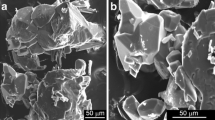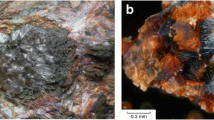Abstract
Based on a study of samples found in the Khibiny (Mt. Rasvumchorr: the holotype) and Lovozero (Mts Alluaiv and Vavnbed) alkaline complexes on the Kola Peninsula, Russia, tinnunculite was approved by the IMA Commission on New Minerals, Nomenclature, and Classification as a valid mineral species (IMA no. 2015-02la) and, taking into account a revisory examination of the original material from burnt dumps of coal mines in the southern Urals, it was redefined as crystalline uric acid dihydrate (UAD), C5H4N4O3 · 2H2O. Tinnunculite is poultry manure mineralized in biogeochemical systems, which could be defined as “guano microdeposits.” The mineral occurs as prismatic or tabular crystals up to 0.01 × 0.1 × 0.2 mm in size and clusters of them, as well as crystalline or microglobular crusts. Tinnunculite is transparent or translucent, colorless, white, yellowish, reddish or pale lilac. Crystals show vitreous luster. The mineral is soft and brittle, with a distinct (010) cleavage. Dcalc = 1.68 g/cm3 (holotype). Tinnunculite is optically biaxial (–), α = 1.503(3), β = 1.712(3), γ = 1.74(1), 2Vobs = 40(10)°. The IR spectrum is given. The chemical composition of the holotype sample (electron microprobe data, content of H is calculated by UAD stoichiometry) is as follows, wt %: 37.5 О, 28.4 С, 27.0 N, 3.8 Hcalc, total 96.7. The empirical formula calculated on the basis of (C + N+ O) = 14 apfu is: C4.99H8N4.07O4.94. Tinnunculite is monoclinic, space group (by analogy with synthetic UAD) P21/c. The unit cell parameters of the holotype sample (single crystal XRD data) are a = 7.37(4), b = 6.326(16), c = 17.59(4) Å, β = 90(1)°, V = 820(5) Å3, Z = 4. The strongest reflections in the XRD pattern (d, Å–I[hkl]) are 8.82–84[002], 5.97–15[011], 5.63–24[102̅, 102], 4.22–22[112], 3.24–27[114̅,114], 3.18–100[210], 3.12–44[211̅, 211], 2.576–14[024].
Similar content being viewed by others
References
Artioli, G., Galli, E., and Ferrari, M., Uric acid dihydrate—a new mineral?, Riv. Mineral. Ital., 1993, no. 4, pp. 261–264.
Artioli, G., Masciocchi, N., and Galli, E., The elusive crystal structure of uric acid dihydrate: implication for epitaxial growth during biomineralization, Acta Crystallogr., Sect. B: Struct. Sci., 1997, vol. 53, pp. 498–503.
Benramdane, L., Bouatia, M., Idrissi, M.O.B., and Draoui, M., Infrared analysis of urinary stones, using a single reflection accessory and a KBr pellet transmission, Spectrosc. Lett.: Int. J. Rapid. Comm., 2008, vol. 41, no. 2, pp. 72–80.
Bridge, P.J., Guanine and uricite, two new organic minerals from Peru and western Australia, Mineral. Mag., 1974, vol. 39, pp. 889–890.
Chesnokov, B.V., Kovalev, E.G., Gorelov, P.N., Kotlyarov, V.A., Bushmakin, A.F., and Zhdanov, V.F. Tinnunculite, C10H12N8O8, a new mineral, in Mineraly i mineral’noe syr’e gorno-promyshlennykh raionov Urala (Minerals and Mineral Resources of Mining Districts of the Urals), Sverdlovsk: UB of RAS, 1989, pp. 20–24.
Chesnokov, B.V. and Shcherbakova, E.P., Mineralogiya gorelykh otvalov Chelyabinskogo ugol’nogo basseina (opyt mineralogii tekhnogeneza) (The Mineralogy of Burnt Dumps in the Chelyabinsk coal basin), Moscow: Nauka, 1991.
Chesnokov, B., Kotrly, M., and Nishanbajev, T., Brennende abraumhalden und aufschlüsse im tscheljabinsker kohlenbecken—eine reiche mineralienkuche, Mineralien-Welt, 1998, vol. 9, no. 3, pp. 54–63.
Chukanov, N.V., Infrared Spectra of Mineral Species: Extended Library, Springer–Verlag, Dordrecht, 2014.
Dosch, W., New urates (II): uric acid and uric acid dehydrate, Fortschritte der Urologie und Nephrologie, 1981, vol. 17, pp. 254–264.
Kolitsch, U. and Habel, M., Harnsäuredihydrat von der Huttwinkelache bei Kolm Saigurn, Rauris, Salzburg, in Neue Mineralfunde aus Österreich. LXI, Niedermayr, G., et al., Eds., Carinthia II, 2012, vol. 202/122, pp. 123–180.
Kolitsch, U. and Raade, G., Uric acid dihydrate: occurrences in austria and norway, Norsk Bergverksmuseum Skrift, 2011, vol. 46, pp. 25–29.
Parkin, S. and Hope, H., Uric acid dihydrate revisited, Acta Crystallogr., Sect. B: Struct. Sci., 1998, vol. 54, pp. 339–344.
Ringertz, H., Optical and crystallographic data of uric acid and its dehydrate, Acta Crystallogr., 1965, vol. 19, pp. 286–287.
Ringertz, H., The molecular and crystal structure of uric acid, Acta Crystallogr., 1966, vol. 20, pp. 397–403.
Schubert, G., Reck, G., Jancke, H., Kraus, W., and Patzelt, C., Uric acid monohydrate—a new urinary calculus phase, Urological Res., 2005, vol. 33, pp. 231–238.
Shirley, R., Uric acid dihydrate: crystallography and identification, Science, 1966, vol. 152, no. 3278, pp. 1512–1513.
Sours, R.E. and Swift, J.A., The relationship between uric acid crystals and kidney stone disease, Am. Crystallogr. Assoc. Trans., 2004, vol. 39, pp. 83–89.
Zellelow, A.Z., Kim, K.-H., Sours, R.E., and Swift, J.A., Solid-state dehydration of uric acid dehydrate, Crystal Growth Design, 2010, vol. 10, pp. 418–425.
Author information
Authors and Affiliations
Corresponding author
Additional information
Original Russian Text © I.V. Pekov, N.V. Chukanov, V.O. Yapaskurt, D.I. Belakovskiy, I.S. Lykova, N.V. Zubkova, E.P. Shcherbakova, S.N. Britvin, A.D. Chervonnyi, 2016, published in Zapiski Rossiiskogo Mineralogicheskogo Obshchestva, 2016, No. 4, pp. 20–35.
Rights and permissions
About this article
Cite this article
Pekov, I.V., Chukanov, N.V., Yapaskurt, V.O. et al. Tinnunculite, C5H4N4O3 · 2H2O: Occurrences on the Kola Peninsula and Redefinition and Validation as a Mineral Species. Geol. Ore Deposits 59, 609–618 (2017). https://doi.org/10.1134/S1075701517070078
Received:
Published:
Issue Date:
DOI: https://doi.org/10.1134/S1075701517070078




